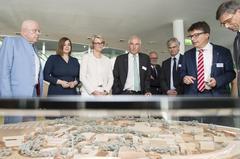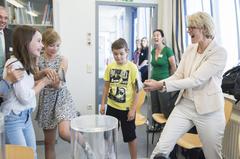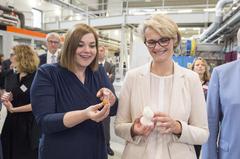URL: https://www.desy.de/news/news_search/index_eng.html
Breadcrumb Navigation
DESY News: Federal Minister of Education and Research, Anja Karliczek, visits DESY
News
News from the DESY research centre
Federal Minister of Education and Research, Anja Karliczek, visits DESY

At the DESY campus model, Federal Minister Anja Karliczek is introduced to DESY´s future projects (from left: Dieter Lenzen, President of Hamburg University, Hamburg´s Research Senator Katharina Fegebank, Federal Minister Anja Karliczek, DESY Director Helmut Dosch, European XFEL Director Robert Feidenhans´l, Jan Louis, Vize President of Hamburg University, DESY´s Administrative Director Christian Harringa, Martin Hecht, Chancellor of Hamburg University, photo: DESY/M. Urban).
“The insights gained at DESY benefit society in wide-ranging ways. Scientists from all sorts of different fields, from medicine and biology, through physics and material science, to the history of art, work side by side at DESY,” said Anja Karliczek. “All around DESY, this science location has developed very favourably. Another example of this is the unique X-ray free-electron laser XFEL, which was inaugurated last year. DESY demonstrates that fundamental research can also provide important impulses for the economy and for start-ups. This is why the federal government invests some 250 million euros into DESY every year.”

Big fun in DESY´s school lab "physik.begreifen" (photo: DESY/M. Urban).
“Following the successful launching of European XFEL, the world’s largest free-electron laser, we want to set out for new shores as outlined in our new strategy, DESY2030,” explains Helmut Dosch, the chairman of DESY’s Board of Directors. “We are very pleased to have the opportunity today of introducing the minister to our ambitious projects for the future, which we intend to realise together with our strategic partners on the campus.”
The flagship of DESY’s new strategy is the project PETRA IV. This circular accelerator is to become the world’s most powerful 3D X-ray microscope, producing images of sequences of events in the nanocosm in 100 times greater detail than can be achieved at present. With this, PETRA IV will be going to the very limit of what is physically possible. Other key elements of the strategy include expanding the free-electron laser European XFEL , setting up a new Centre for Data and Computing Science, and strengthening technology transfer and innovation. The DESY site in Zeuthen is to be expanded to become an international centre for astroparticle physics, focusing on gamma ray and neutrino astronomy.

Katharina Fegebank looks at the only 2.6 micrometer sample of a catalyst investigated at PETRA III while Anja Karliczek holds a 3D model of it at a 20 000:1 scale (photo: DESY/M. Urban).
DESY is one of 18 research centres within the Helmholtz Association, which studies great and important questions of society, science and the economy through strategic and programmatic top-class research in six areas of research. The Helmholtz centres receive 90 percent of their funding from the German Ministry of Education and Research (BMBF), with 10 percent coming from the federal states in which they are located.



